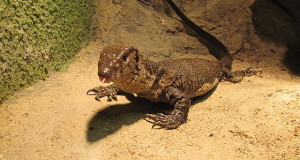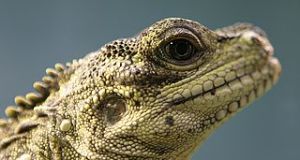Click: The Monitor Lizards (Family Varanidae) – Family Overview and Species Accounts; – Some Interesting Monitors and Their Care – Part I, to read the first part of this article.
Merten’s Water Monitor, Varanus mertensi
The popularity of this most aquatic of the world’s monitor lizards is soaring, and with good reason – it is active, hardy, of manageable size (averages 3 feet in length, occasionally to 4) and very responsive to its surroundings.
Range
Native to northern and western Australia (Northern Territory, Queensland, South Australia and off-shore islands), Merten’s water monitors frequent creeks, rivers, canals, ponds and reservoirs. They bask on the shore or low overhanging branches, and rarely stray far from the water’s edge. Although common at present, this situation may change – water monitors readily consume introduced marine toads, and many are killed by the amphibians’ toxins.
Unique Adaptations
Merten’s water monitors, named after eminent Russian-born herpetologist Robert Mertens (1894-1975) of Frankfurt Germany’s Seckenberg Museum,
are deep brown to black in color, with dark-edged cream or yellow spots. The tail is laterally compressed and the nostrils, which can be sealed during dives, are located high on the snout.
Housing
Water monitors require a spacious cage (at least 4’x4’x 3′), a UVB source and a large (preferably drainable) pool. They must be able to bask at 90-95 F and to dry off completely upon leaving the water.
Diet
The natural diet consists largely of crabs, crayfish and fish, but frogs, tadpoles, turtle and other reptile eggs, shrimp, snails, nestling birds, planigales and other small mammals, large insects and carrion are also taken. They have been observed foraging in dumps, with discarded sausages apparently being a favored food! Water monitors use their tails to concentrate small fishes when hunting in the shallows.
Captives should not be fed a rodent-based diet, but rather one weighed heavily in favor of whole, fresh-water fish, whole, unshelled prawn, crayfish, roaches, crickets, earthworms, and canned insects/monitor diets . Pink mice are preferable to furred rodents, and should be offered only once each week or two. This species seems to have a quite high metabolism, and does best when fed small meals every 3-4 days.
Blue Tree or Blue-Spotted Tree Monitor, Varanus macraei
This strikingly colored lizard only appeared in zoos in the late 1990’s, and was not named as a distinct species until 2001. Never-the-less, beauty and small size (to 40 inches) has propelled it to the top of the “most desired species lists” of many monitor fanciers.
These slender monitors are jet black in color and variably patterned with blue spots and bands. The prehensile tail comprises 2/3 of the animal’s length.
Range
Blue tree monitors are found only on Batanta Island, Indonesia (off Irian Jaya, New Guinea). Almost entirely arboreal, they inhabit trees and shrubs within rainforests and estuarine swamps. Their wild status is unknown, but the species is listed on CITES Appendix II due to the extremely limited natural range.
Housing
Blue tree monitors require a spacious cage with provisions for climbing, UVB light and a basking spot of 90-95 F. The several pairs I’ve kept have co-existed without incident, and frequently rested in close contact with one another. Quite shy and quick to take flight, they do best in a well-planted cage provided with numerous hideaways and located in a quiet area. This is a species to observe, not handle.
Diet
The natural diet is likely composed largely of invertebrates such as tree crickets, katydids, snails, caterpillars and spiders, along with occasional treefrogs, lizards, small birds and their eggs, nestling mice and other small mammals.
As with other small monitors, I prefer not to feed too many rodents to this species. Mine thrive upon waxworms, crickets, crayfish, super mealworms, roaches, chicks and quail eggs. Pink mice are given every two weeks or so. Canned insects and monitor diets are often accepted and should be included as a source of dietary variety.
Breeding
Females lay 2-6 eggs at a time, and may produce up to 6 clutches per year (this may be a function of food availability in captivity). The young average 5 inches in length and hatch after an incubation period of 200-225 days. Captive females will bury eggs within moist substrates on the ground but seem to prefer arboreal nest boxes.
An Escapee that Made the Most of His “Vacation”
The long, slender tail of this monitor is prehensile and adds to its climbing abilities and agility. Alert and quick moving, blue tree monitors can catch even the swiftest of prey in their treetop homes. One individual that escaped from an exhibit at the Bronx Zoo was in the process of swallowing a house sparrow when I recovered him from atop a vine-covered fence!
In depth information about the family Varanidae and its individual species is posted at:
http://www.tigr.org/reptiles/families/Varanidae.html
 That Reptile Blog – Reptile, Amphibian and Exotic Pet Care and Information
That Reptile Blog – Reptile, Amphibian and Exotic Pet Care and Information




this is the first and only place i have found any info on the blue tree monitor. thank you very much i am still searchiong for a breeder i am trying to purchase a few of these beautiful monitors i have several other monitors but this one is my first love for monitors that is thank you for your info.
Hello Angela,
Frank Indiviglio here.
It was so nice to see your kind comment…thanks very much for taking the time to write.
Below is a link to the chapter on blue tree monitors in Varanoid Lizards of the World (Pianka & King, eds.), which can be read online. It provides an account of the species’ “discovery” and what is known of its natural history. The book itself is an excellent source of information on monitors in general.
Blue tree monitors are, as you’ve noticed, quite scarce in the trade. I worked with them in zoo collections, but even there they are not common.
Please write in with any questions or observations you may have, and again, your consideration is much appreciated.
Best regards,
Frank Indiviglio
Frank,
I have found a pair of Varanus macraei for sale, and am considering breeding them. I have experience breeding other herps, mostly chameleons, and would like some resources before I start on this. Are there any good guides/journal articles out there? Most of my questions lie in determining that the female is receptive, and assuring that she does not become egg-bound. Many thanks.
jon